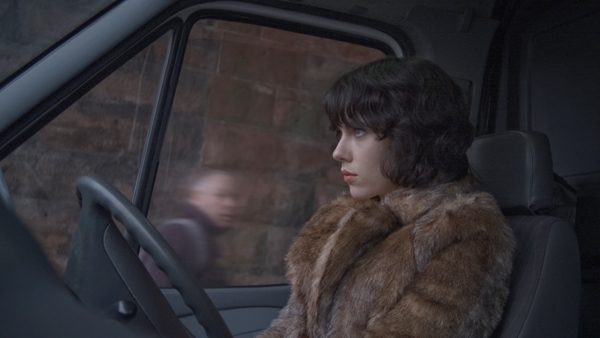![]() If you’re looking for a movie in which Scarlett Johansson gradually and delicately learns what it means to be a woman in the world, you don’t have to watch a certain Sofia Coppola film anymore! Go no further than to director Jonathan Glazer when looking to be mesmerized and intellectually challenged—a serious cinematic experience becoming rarer and rarer.
If you’re looking for a movie in which Scarlett Johansson gradually and delicately learns what it means to be a woman in the world, you don’t have to watch a certain Sofia Coppola film anymore! Go no further than to director Jonathan Glazer when looking to be mesmerized and intellectually challenged—a serious cinematic experience becoming rarer and rarer.
Offering his third excellent feature, this mainstream film artist crafts the painfully complete story of an unearthly stranger posing as a beautiful woman who daily lures men into a mortal trap. One day she (it?) has what we would probably categorize as a crisis of conscience, and she escapes off into a rural Scottish community, tracked by an imposing male counterpart who dons a full motorcycle suit, helmet, and badass regalia. The protagonist (unnamed) makes her way carefully through a small town, now suddenly out of her element, encountering men of differing degrees of threat until a remarkably memorable ending that will undoubtedly stay lodged in your memory for a long time.
Glazer allows us access to the mystery throughout the first half by incrementally revealing more and more details of the events surrounding the abductions of the men, so we have a pretty good handle on at least what is going on. The question of why is unequivocally left unanswered, though one of the most beautiful things about the film is that it absolutely doesn’t matter. It’s about someone teaching herself to be a woman and learning how men respond to her. First, she is a predator, using her alluring sexuality (and boy, is it alluring) to ensnare a host of horny, unsuspecting young men. In the second half, away from her safe pattern, she is vulnerable. And suddenly, each man we see is emphasized, overblown.
The concept of Man becomes coded due to the earlier events. Man equals victim. Now, suddenly, the illusion is dropped, and each man’s desire, instead of a criterion used to control him, becomes a weapon that harms. Glazer, who wrote the screenplay based on the novel of the same name by Michel Faber, pares his own themes down from Faber’s more layered and far-reaching implications, just as he narrows the details of the plot. Faber includes more commentary on contemporary industrial civilization, in the process offering much more why.
Glazer tells a more focused, emotionally resonant story about sexuality, humanity, and personal identity. Yet when one examines the main character, her arc has amazing depth. It’s no wonder such an opaque story feels so completely told. This woman goes through a litany of life lessons in a very short amount of time, learning 1) what it means to feel for someone, 2) to be brave, 3) to be of the fairer sex, and 4) what a vagina is.
Remarkably filmed by Glazer collaborator Daniel Landin, every third shot or so is just breathtaking. Exhaustive attention has been paid to every frame. Likewise, the score by Mica Levi is unforgettable. Glazer is rightly compared, by many, to Kubrick, and it’s in the details of his scene construction that the comparison is most valid. Third on my list of high points is Johansson herself. She is a blindingly attractive woman, and could very easily be a distraction in such a comprehensively intellectual pursuit—especially since she takes her clothes off several times. Glazer instead justifies this sexual object by designing the film around her, and actually intellectualizing her beauty. Gaze, yet, in doing so, understand.
The ending. Oh, the ending. No spoilers here. See the film, call me, and let’s just talk and talk about it. Tears in my eyes looking back at my notes. After watching her in such a precarious journey of discovery, just about anything that happens to her will be compelling. I’d be amazed if there’s anyone reading this is without a trace of cynicism about our global-warming, misogynistic, factory-farming modern society, and who finds themselves genuinely surprised at how said society receives a naïve and sensitive alien life form in over her head. In other words, have you seen E.T. the Extra-Terrestrial?







Leave A Comment